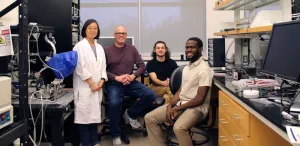(Press-News.org) The behaviors and actions of hypersocial species like humans are heavily influenced by the behaviors and actions of those around them. This was evidenced throughout the COVID-19 pandemic; protective measures such as masking and social distancing varied widely as these behaviors were affected by where people were and who they were around, which in turn affected disease prevalence and transmission rates.
Now, researchers from the School of Arts & Science at the University of Pennsylvania and Queen’s University in Canada have produced a theoretical model for disease transmission that factors in the effects of social dynamics, specifically, how non-pharmaceutical interventions (NPI) like masking and social distancing are affected by social norms.
The research, published in the Proceedings of the National Academy of the Sciences, shows that social conformity creates a type of “stickiness” wherein individuals are reluctant to change their NPI usage if it differs from what others are doing.
“Generally, when there’s an infectious disease going around, rational actors are uncomfortable taking risks and will try to avoid getting sick, so naturally you’d think that they’d change their behaviors based on these concerns,” says Erol Akçay, associate professor of biology at Penn. “But it turns out populations, and by extension disease transmission rates, are equally, if not more, affected by social norms.”
The researchers aimed to better understand of how the prioritization of risk and social norms affects the adoption of NPIs during a pandemic.
To achieve this, they developed a model that considers the risk of infection, the cost of NPIs, and the social cost of deviating from NPI-usage norms. The model describes threshold dynamics in the number of individuals needed to support a behavioral change, which creates “tipping points” in the adoption of NPI behaviors where a small change in the disease prevalence can cause a significant shift in population behavior.
“Our model found that small changes in certain factors like the effectiveness of NPIs, transmission rate, and costs of interventions can lead to large changes in rate of disease spread, or attack rate,” Akçay says.
He explains that this is in part due to people being conformist and therefore slow to adopt new behaviors such as mask wearing, until the disease reaches levels so high that the risk perception overrides conformity, when the population tips over. Conformism works the other way, too; the new behavior persists longer in the population than it would if people cared only about their individual risks and costs. This creates distinct infection and NPI behavior waves.
As variables such as the cost or effectiveness of the NPI behavior change, it can create more or fewer waves of change and lead to more or fewer people infected at the end of the epidemic. The researchers found that the attack rate did not increase as smoothly as anticipated; rather, it had a more “sawtooth look” when graphed. These results highlight a complex relationship between social norms and disease spread.
“It increases and then decreases, over and over, and we noticed this trend in other parameters, even the transmission rate,” says first author Bryce Morsky, who started working on this project as a postdoctoral researcher in Akçay’s lab and is now an assistant professor at Florida State University.
The team, which also includes Felicia Magpantay and Troy Day from Queen’s University in Canada, explains that when they ran an epidemiological simulation with no NPI use at the start of the epidemic they had a predictably high attack rate, and eventually, individuals began NPI usage due to fears of infection risk.
The onset of NPI usage, however, comes much later when the parameters for the cost of deviating from social norms are set higher “because if nobody’s masking you don’t want to be the first person,” Akçay says.
“So, increasing this parameter leads to a delay in masking, which drives the first wave of the epidemic much higher than it would have been if individuals were reacting to their risk levels. On the other hand, when we ran the simulation with masking and the case numbers started going down, there was a reluctance to stop masking because nobody wanted to be the first person to stop masking, which we referred to as stickiness.”
Morsky explains that the model was initially motivated by some results from a previous study investigating social norms and their effects as it relates to reciprocity behavior, where conformist behavior can induce boom-and-bust cycles in cooperative communities. Here, conformist behavior makes epidemic waves inherently more distinct than they would have been otherwise, even in the absence of external factors such as seasonal variation in transmission rates.
Akçay says that information on these trends and social dynamics can be useful for policymakers weighing decisions about responding to human behavior. And the researchers want to investigate how the interplay of different populations and socioeconomic backgrounds affects the social behaviors of disease intervention.
Erol Akçay is an associate professor in the University of Pennsylvania School of Arts & Sciences’ Department of Biology.
Bryce Morsky was a postdoc at Penn and is now an assistant professor at Florida State University.
The work was supported by the One Society Network funded by the Natural Sciences and Engineering Research Council of Canada and the U.S.-Israel Binational Science Foundation.
END
Social conformity in pandemics: How our behaviors spread faster than the virus itself
Researchers have produced a model for disease transmission that factors in the effects of social dynamics, specifically, how masking and social distancing are affected by social norms
2023-05-10
ELSE PRESS RELEASES FROM THIS DATE:
Study proves efficacy of remote physical training in rehabilitation of severe COVID patients
2023-05-10
Researchers at the University of São Paulo (USP) in Brazil have created an exercise training program that survivors of severe COVID-19 can safely perform at home as rehabilitation therapy for persistent symptoms after they are discharged from hospital. Findings of a study recently reported in the British Journal of Sports Medicine show that exercise can improve the quality of life for these patients, benefitting their health and functionality while reducing the number of persistent symptoms, such as muscle pain and weakness.
Long COVID (also known as post-COVID-19 syndrome) affects more than 40% of people who ...
17 percent of U.S. households face growing water affordability challenge
2023-05-10
DURHAM, N.C. – In 787 communities served by the United States’ largest utilities, 17 percent of households struggle to afford basic water services, according to a new analysis by researchers at Duke University.
Nearly half the U.S. population lives in the communities covered by the analysis, which was published May 10 in the open-access journal PLOS Water. The analysis shows that 28.3 million people in those communities live in households that spend more than one day each month working to pay for water ...
Protein nanoparticle vaccine with adjuvant improves immune response against influenza, biomedical sciences researchers find
2023-05-10
ATLANTA—A novel type of protein nanoparticle vaccine formulation containing influenza proteins and adjuvant to boost immune responses has provided complete protection against influenza viral challenges, according to a new study published by researchers in the Institute for Biomedical Sciences at Georgia State University.
The findings published in the journal Small describe a promising influenza vaccine candidate that uses adjuvants, substances that increase immune response to a vaccine, to boost effectiveness against ...
Songs of the oceans raise environmental awareness #ASA184
2023-05-10
CHICAGO, May 10, 2023 – For many people, there are few sounds as relaxing as ocean waves. But the sound of the seas can also convey deeper emotions and raise awareness about pollution.
At the upcoming 184th Meeting of the Acoustical Society of America, Colin Malloy of Ocean Network Canada will present his method to transform ocean data into captivating, solo percussion songs. The talk, “Sonification of ocean data in art-science,” will take place Wednesday, May 10, at 3:25 p.m. in the Indiana/Iowa room. The meeting will run May 8-12 at the Chicago Marriott Downtown Magnificent Mile Hotel.
To construct his compositions, Malloy employs sound from ...
Sleep apnea, lack of deep sleep linked to worse brain health
2023-05-10
EMBARGOED FOR RELEASE UNTIL 4 P.M. ET, WEDNESDAY, MAY 10, 2023
MINNEAPOLIS – People who have sleep apnea and spend less time in deep sleep may be more likely to have brain biomarkers that have been linked to an increased risk of stroke, Alzheimer’s disease and cognitive decline, according to new research published in the May 10, 2023, online issue of Neurology®, the medical journal of the American Academy of Neurology. The study does not prove that these sleep disturbances cause the changes ...
Virginia Tech researchers conduct proof-of-concept study on mosquito’s scent preferences
2023-05-10
Humans smell. Each and every person has a unique body odor.
People have been using commercial products to alter their scent for generations. From soaps to perfumes, people gravitate to floral and fruity smells.
Whether we think these smells are good or bad is of little consequence to mosquitoes, transmitters of diseases that kill hundreds of thousands of people each year. Additionally, mosquitoes rely on plant nectar to get some sugars needed to sustain their metabolism in addition to needing nutrients in the blood to produce eggs.
And humans with nutrients and a floral scent? That’s two strikes.
In spite of these scents being right under humans’ noses, the impact of ...
Older adults are more easily distracted, study reports
2023-05-10
RIVERSIDE, Calif. -- While engaged in a physical task requiring effort, such as driving a car or carrying grocery bags, older adults are more likely than younger adults to be distracted by items irrelevant to the task at hand, a University of California, Riverside, study reports.
The study assessed the interaction between physical exertion and short-term memory performance when distractors were present or absent in younger and older adults.
“Action and cognition, which interact often in daily life, are sensitive to the effects of aging,” said graduate student Lilian Azer, the first author of the research paper published ...
Texas A&M Institute for Advancing Health through Agriculture seeks experts to support study on responsive agriculture
2023-05-10
College Station, Texas (May 10, 2023) – Texas A&M’s Institute for Advancing Health Through Agriculture (IHA) is spearheading a study that focuses on advancing the concept of responsive agriculture and is seeking experts and leaders in the agriculture-food value chain to serve one of its three committees. The committees, along with a recently named Task Force, will help develop a road map to achieve responsive agriculture, an agricultural system and food environment that supports health ...
How does the brain interpret taste?
2023-05-10
NORMAN, OKLA. – Taste is a complex neurological experience that has the potential to provide extensive, and perhaps surprising, information on how the brain makes sense of sensations and the organization of brain pathways. A research project funded by the National Institutes of Health, led by Christian H. Lemon, Ph.D., an associate professor in the Department of Biology in the Dodge Family College of Arts and Sciences, aims to better understand how the brain processes taste and how those neural pathways can evolve.
Taste ...
ACM and CSTA announce 2022-2023 Cutler-Bell student winners
2023-05-10
The Association for Computing Machinery (ACM) and the Computer Science Teachers Association (CSTA) announced four high school students were selected from among a pool of graduating high school seniors throughout the US for the ACM/CSTA Cutler-Bell Prize in High School Computing. Eligible students applied for the award by submitting a project/artifact that engages modern technology and computer science. A panel of judges selected the recipients based on the ingenuity, complexity, relevancy, and originality of their projects.
The Cutler-Bell Prize promotes ...
LAST 30 PRESS RELEASES:
Journal of Nuclear Medicine Technology supplement highlights advances in theranostics and opportunities for growth
New paper rocks earthquake science with a clever computational trick
ASH 2025: Milder chemo works for rare, aggressive lymphoma
Olfaction written in bones: New insights into the evolution of the sense of smell in mammals
Engineering simulations rewrite the timeline of the evolution of hearing in mammals
New research links health impacts related to 'forever chemicals' to billions in economic losses
Unified EEG imaging improves mapping for epilepsy surgery
$80 million in donations propels UCI MIND toward world-class center focused on dementia
Illinois research uncovers harvest and nutrient strategies to boost bioenergy profits
How did Bronze Age plague spread? A sheep might solve the mystery
Mental health professionals urged to do their own evaluations of AI-based tools
Insufficient sleep associated with decreased life expectancy
Intellicule receives NIH grant to develop biomolecular modeling software
Mount Sinai study finds childhood leukemia aggressiveness depends on timing of genetic mutation
RSS Research Award for new lidar technology for cloud research
Novel AI technique able to distinguish between progressive brain tumours and radiation necrosis, York University study finds
Why are abstinent smokers more sensitive to pain?
Alexander Khalessi, MD, MBA, appointed Chief Innovation Officer
Optical chip pioneers physical-layer public-key encryption with partial coherence
How your brain understands language may be more like AI than we ever imagined
Missed signals: Virginia’s septic strategies overlook critical timing, study warns
Delayed toxicities after CAR T cell therapy for multiple myeloma are connected and potentially preventable
Scientists find cellular key to helping plants survive in saltwater
Medical cannabis program reduces opioid use
Immunotherapy works for sepsis thanks to smart patient selection
Cardiovascular events 1 year after RSV infection in adults
US medical prices and health insurance premiums, 1999-2024
Medical cannabis and opioid receipt among adults with chronic pain
Multichannel 3D-printed bioactive scaffold combined with siRNA delivery for spinal cord injury recovery
Triaptosis—an emerging paradigm in cancer therapeutics
[Press-News.org] Social conformity in pandemics: How our behaviors spread faster than the virus itselfResearchers have produced a model for disease transmission that factors in the effects of social dynamics, specifically, how masking and social distancing are affected by social norms






